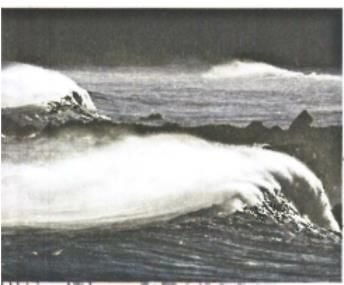Textbook Solutions: Break, Break, Break | Gul Mohar Class 7: Book Solutions, Summaries & Worksheets PDF Download
Before You Read
Look at this Picture.

Choose the words that you think describe this scene. Say why you chose them.
• peace
• turmoil
• mystery
• hope
• longing
• great sadness
Ans: “Great sadness” and “longing” fit the scene. The poem shows Tennyson’s grief after losing his close friend. His yearning for what cannot return makes the tone sorrowful and filled with deep emotional loss.
Understanding the Poem
Answer these Questions.
Q1. Who or what is being addressed in the first line?Ans: The sea is being addressed directly. The poet speaks to the waves as if they can listen. The sea becomes a symbol of his endless grief and his deep emotional state of loss.
Q2. In the first stanza, what does the speaker wish he could do? What does it say about his state of mind?
Ans: He wishes he could express his sorrow in words. This shows his pain is so strong that it cannot be spoken. His mind is heavy with grief that remains unexpressed.
Q3. Look at the second and third stanzas. What has been described and what is it in contrast to? How does the contrast sharpen the emotions in the poem? (Think about how people go on with their ordinary activities while the speaker is grieving—look at the contrast in these situations.)
Ans: Children playing and sailors working are described. This contrasts with the poet’s grief. The contrast sharpens his pain, showing how life goes on for others while he suffers silently.
Q4. Will never come back to me. What will never come back to the speaker? Why?
Ans: The “tender grace of a day that is dead,” meaning his friend Arthur Hallam, will not return. Death has taken him away forever, leaving the poet with permanent grief and emptiness.
Q5. What is the difference between sadness and grief? What are the lines that bring out the grief of the speaker? Underline them.
Ans: Sadness is ordinary sorrow, while grief is deep pain caused by great loss. The lines: “But the tender grace of a day that is dead / Will never come back to me.” show grief.
Q6. How does the poem show that life and nature go on despite what happens to human beings? How is this idea linked to the sea?
Ans: Children play, fishermen work, and ships sail while the sea keeps breaking endlessly. This shows nature continues in its rhythm. The sea symbolises how life moves on even after human suffering.
Appreciating the Poem
Q1. This poem uses personification in the first stanza. Which thing is given human qualities and how?Ans: The sea is personified. The poet commands it with “Break, break, break,” as if it can hear and respond. This makes the sea a living presence sharing his grief.
Q2. Which words have been repeated in the poem? What effect does the repetition produce?
Ans: The word “break” is repeated. It shows the restless, ceaseless waves and reflects the poet’s endless grief. The repetition creates rhythm and highlights the pain in his heart.
Q3. (a) Which words, phrases or lines express sadness and longing (a strong desire, especially for something which is difficult or impossible to have)?
Ans: “The tender grace of a day that is dead / Will never come back to me.” These lines show his deep longing and grief for his lost friend, which will never end.
(b) Which stanza captures a different mood—one of joy and light-heartedness?
Ans: The stanza describing “the fisherman’s boy” and “the sailor lad” shows a cheerful mood. It contrasts with the sadness of the poet, highlighting life’s normal joys against his grief.
Q4. Silence—or the inability to speak—has been mentioned twice in this poem. Who are the two people who cannot speak? Why?
Ans: The poet cannot speak as grief chokes his words. His friend cannot speak since he is dead. Both silences show the power of death and the deep pain of loss.
|
28 videos|56 docs|17 tests
|
FAQs on Textbook Solutions: Break, Break, Break - Gul Mohar Class 7: Book Solutions, Summaries & Worksheets
| 1. What is the main theme of the poem "Break, Break, Break"? |  |
| 2. How does the structure of the poem contribute to its meaning? |  |
| 3. What imagery is used in the poem, and what effect does it create? |  |
| 4. Who is the speaker in "Break, Break, Break," and what are their feelings? |  |
| 5. How does the poem relate to the concept of nature and human emotion? |  |





















